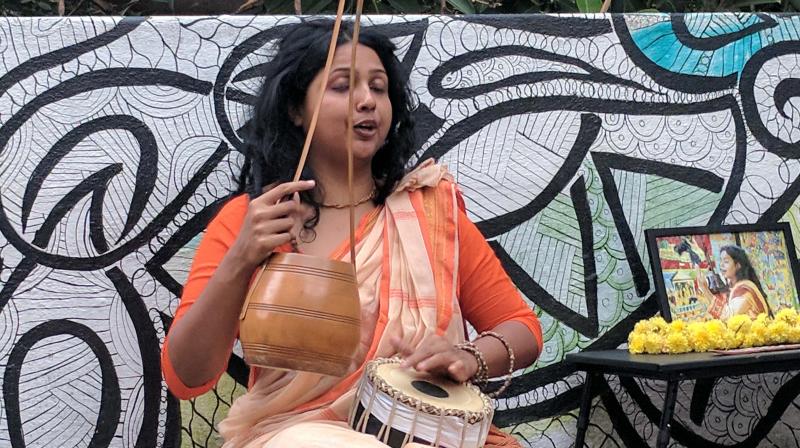Gender Roles Over Centuries

History repeats itself is a clichéd phrase but nonetheless, a powerful one. The role of women in age-old folk stories cast a light on the adversities faced by them, mostly because of societal perceptions. On the International Women’s Day, we look at some popular oral traditions and how two women are trying to cast a light on what was and what it is now.
Shilpa Mudbe Kothakota, co-founder of the city-based Urban Folk Project (UFP) has taken up the stories of Goddess Yellamma whose temples are across South India and even in Sri Lanka. Even as she researches, archives and documents the lesser known folk forms and stories, she speaks of the communities related to Yellammanaata. “We started our journey with Yellammanaata, a ritualistic overnight play telling the story of the transformation of a princess named Renuka into the powerful goddess Yellamma. Her devotees include the Jogathi (transgender women disciples), Jogamma, Jogappa and the devadasi communities. We followed them to document the rare and dying forms of Chowdkipada and Jogathi Nritya and along the journey met powerful performers.”
The upcoming performance by UFP is about ‘Yellamma and other stories’ wherein there are stories not only of Renuka and Yellamma but also the stories of those who are following the Goddess - the devadasis and Jogathis from whom they have learnt the various songs. How would the story of Renuka inspire women? “More than inspiration, it is about learning from her mistakes,” Shilpa said.
Desperate to be a mother, Renuka begs Lord Shiva to bless her with a child even though the son would ultimately kill her. It seemed like the identity of the woman was inseparable from being a mother. “Even after eight years of marriage, I am asked when I will have kids,” said Shilpa, throwing a light on the ‘sameness’ of the scenario. One of her folk storytelling mentors, Manjamma Jogathi, is a transgender who usually performs as Renuka. Jogathis are performative metaphors for Renuka and through her they go through all that a woman goes through including childbirth. Then there is the scene when Parshurama, the son of Renuka, drags his mother in order to kill her. During the 45-minute piece, Renuka sings about her sorrow and the betrayal of trust.
The song soon becomes a song of betrayal that will resonate with the audience who can relate it to their own experiences of betrayal. “Folk stories have changed so many times, unlike mainstream Sanskritised ones, that it becomes all inclusive and give closure to peole,” Shilpa notes.
The power of such storytelling is such that they have changed across villages, regions and scenarios. From versions where Renuka rids herself of all men in her life and forming a community of devadasis to incorporating the stories of Radhamma, a devadasi who has taught stories of her community, Shilpa and UFP aim at telling stories that feel more in the present.
The other powerful oral tradition which Arpita is highlighting is about Baul that was prevalent in Bengal region of West Bengal, Tripura, Assam’s Barak Valley and Bangladesh. More than thousand years old, Baul poetry and music has influences of Islam, Buddhism and Hinduism. As Arpita points out, it is a very spontaneous tradition and is constantly responding to the times with a lot of humour. There are songs on caste, peace, religion, humanity and gender. Arpita, who has been doing Baul since three and a half years, dances and sings, using the ektara (a one-stringed instrument), dukki (handheld earthen drum) and ghungroos (anklets).
“But Baul is beyond performative art,” she says. "It is more like a meditative practice to return to ourselves. " The mind has to be in the present to be able to wield the duggi and ektara while singing and dancing. The aspiration of Baul is to become the song. “As a woman, you may be the daughter, wife or mother, but none of that matters when performing Baul. It's about just being..”
While Baul is about questioning the status quo, one aspect of it is the story of Radha and Krishna together. Generally, in Indian mythology Radha’s figure is a little contentious. Arpita explains, “She is not Krishna’s wife but his lover. They are together as equals but then she is deeply devoted to him. But in the story of Chaitanya Mahaprabhu, one of the first masters of Baul music, Radha loves Krishna so much that he felt obligated to return her love. He couldn’t find any way to do it but to be reborn in the same body of Radha so that she could be with him for a lifetime.
The strength of devotion has been portrayed in such a way that the divine has to respond. Bauls believe that the feminine capacity to love is so important.” Even though women performers are rare in Baul there are enough stories embodying the freedom and autonomy a woman can have. One such story, Ogo Radhe teases Radha about her lover Krishna who is leaving for Mathura and her relationship with her husband Ayan. “In this Baul story, the choice is with Radha,” Arpita says. “She is so free and so in the present.”
So, as far as traditions go, two strong ones depict gender issues through exquisite storytelling. As they course through generations, the role of women across timelines have a parallel story to tell. It is then that history scores a point.

